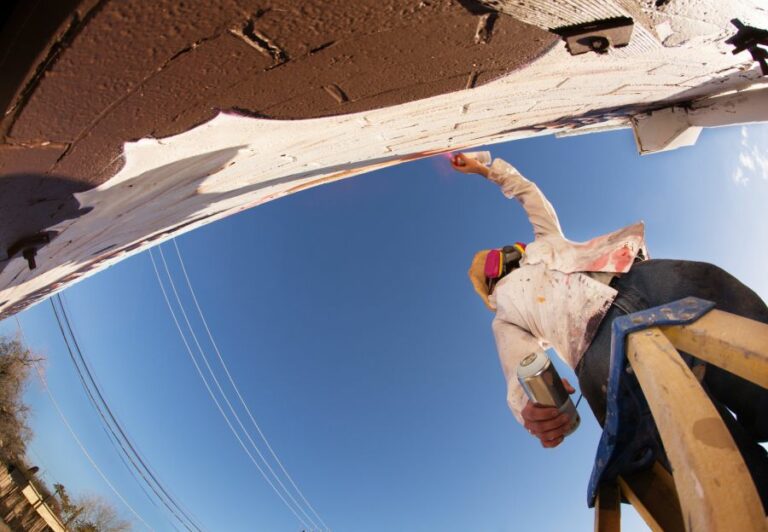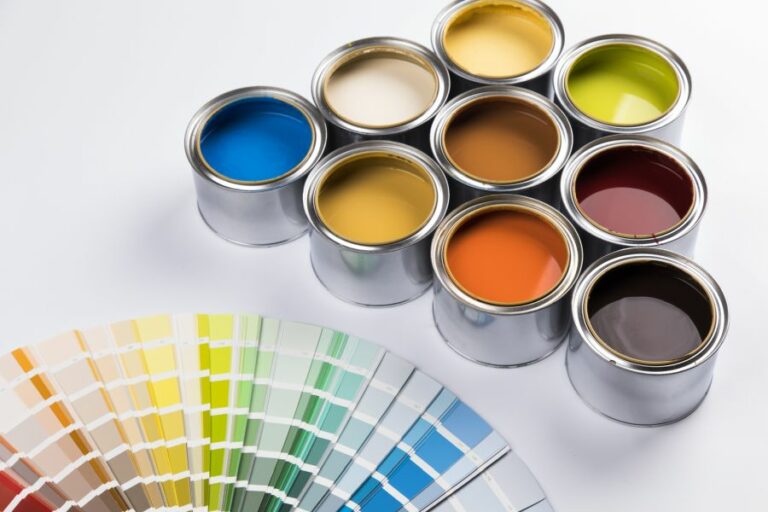What Paint To Use On Outdoor Wooden Bench, 25 Things You Should Know
Looking to revamp your outdoor wooden bench by adding a fresh coat of paint? By choosing the right paint, you’ll not only enhance your space’s beauty but also prolong your furniture’s life. I’ll guide you through selecting the perfect paint that suits your taste and provides protection against the elements while creating a durable finish.
What paint to use on the outdoor wooden bench:
To select the right paint for an outdoor wooden bench, consider durability, safety, adhesion, ease of application, and desired finish. Choose from latex, acrylic, oil-based paint, or solid stain, each with specific benefits and drawbacks. Recommended products include Behr Premium Plus Exterior Paint, Benjamin Moore Aura Exterior Paint, Rust-Oleum Protective Enamel Paint, and Behr Premium Solid Color Waterproofing Exterior Wood Stain. Ensure proper preparation and application for a long-lasting, beautiful finish.

Explore the world of paints specifically designed for outdoor wooden benches! Learn about the best types, application methods, and factors to consider when choosing paint for durability, weather resistance, and overall aesthetics. Unlock your bench’s potential with the perfect paint!
Contents
- 1 Appropriate Paint Selection for an Outdoor Wooden Bench
- 2 What Type of Stain Should You Apply on an Exterior Wooden Bench?
- 3 What is the Ideal Paint Type for Painting a Wooden Bench?
- 4 How can you effectively weatherproof an outdoor wooden bench for long-lasting use?
- 5 What are the suitable options for painting a wooden bench?
Appropriate Paint Selection for an Outdoor Wooden Bench
An outdoor wooden bench is a beautiful and functional addition to any garden, patio, or backyard. It’s important to select the right paint for the job to keep it looking its best and protect it from the elements.
• Factors to Consider When Choosing Paint for Outdoor Wooden Benches
– Durability
One of the main factors to consider when choosing paint for an outdoor wooden bench is its durability. The paint should be able to withstand varying weather conditions and protect the wood from moisture, sun, and other environmental factors that can cause damage.
– Safety
Another important factor is the safety of the paint. Look for paints that are non-toxic, low-VOC (volatile organic compound), and safe for use around children and pets.
– Adhesion
Choose a paint that bonds well to wood surfaces to ensure a long-lasting finish.
– Ease of Application
Go for paints that are easy to apply and have good coverage to minimize the number of coats needed.
– Finish
Decide on the desired finish for your bench. There are several options available, including matte, satin, semi-gloss, and gloss finishes.
• Types of Paint for Outdoor Wooden Furniture
– Latex Paint
Latex paint is a popular choice for painting outdoor wooden furniture because of its durability and ease of use. It is water-based and generally dries quickly, which makes it ideal for outdoor applications. Latex paint also tends to be more resistant to fading, peeling, and cracking and is available in various finishes.
Expert Recommendation: An excellent latex paint option for outdoor wooden benches is the Behr Premium Plus Exterior Paint & Primer. This paint offers excellent adhesion, coverage, and durability and is available in a variety of finishes.
– Acrylic Paint
Acrylic paint is another excellent choice due to its durability and resistance to moisture, mildew, and fading. It is also easy to clean up and dries quickly. High-quality acrylic paint will provide a long-lasting finish for your outdoor wooden bench, ensuring its color and protection last for years to come.
Expert Recommendation: Benjamin Moore Aura Exterior Paint is a top-quality acrylic paint that provides excellent adhesion, durability, and coverage. This paint comes in various finishes, making it a great option for outdoor wooden benches.
– Oil-Based Paint
Although oil-based paint is known for its durability and coverage, it has a longer drying time and requires more careful cleanup compared to water-based paints.
However, oil-based paint is still an option for outdoor wooden benches, especially if the surface has been previously painted using oil-based paint.
Expert Recommendation: If you prefer oil-based paint, consider the Rust-Oleum Protective Enamel Paint. This paint provides excellent protection against rust and corrosion and is available in a variety of finishes.
– Solid Stain
Solid stains are not technically paints but are another suitable option for outdoor wooden furniture. They provide excellent durability, are resistant to mildew and water, and maintain the natural texture of the wood.
Expert Recommendation: The Behr Premium Solid Color Waterproofing Exterior Wood Stain & Sealer is a high-quality solid stain that offers excellent protection and durability for your outdoor wooden bench.
• Tips for Preparing and Painting Your Outdoor Wooden Bench
- Clean the bench thoroughly to remove dirt and mildew.
- Sand the bench to remove any peeling paint or rough patches, and wipe away dust and debris.
- Apply a wood primer before painting to ensure better adhesion and coverage.
- Apply the paint or stain of your choice, following the manufacturer’s instructions for the number of coats required and the recommended drying time between coats.
- Consider sealing the bench with a clear exterior varnish or spar urethane for added protection.
In conclusion, the key to choosing the right paint for your outdoor wooden bench is to consider factors such as durability, adhesion, and ease of application.
Being aware of the types of paint available: latex, acrylic, oil-based, and solid stain, and their specific benefits and drawbacks will enable you to make an informed choice for a beautiful, long-lasting finish.
Finally, following the proper preparation and application steps will ensure the best results for your freshly painted outdoor wooden bench.
What Type of Stain Should You Apply on an Exterior Wooden Bench?
An outdoor wood bench is a perfect addition to your garden, patio, or any other outdoor space, acting as both practical seating and an attractive design element. To ensure the longevity of your bench and maintain its appearance, it’s essential to protect the wood from the elements with a stain.
– Types of Wood Stains and Their Features
Several types of wood stains are on the market, each offering different benefits and appearances. The primary types include oil-based, water-based, and solid-color stains.
Oil-Based Stains
Oil-based stains are popular for outdoor benches, as they provide excellent penetration and durability. The oils in these stains help to repel water, protecting the wood from moisture damage.
- Pros: Highly durable, water-repellent, and easy to apply
- Cons: Longer drying times, may require a separate sealer or finish for added protection
Water-Based Stains
Water-based stains have become increasingly popular in recent years, thanks to their lower environmental impact, quicker drying times, and easy clean-up. They offer good protection against moisture and UV damage, though they may not last as long as oil-based stains.
- Pros: Quick-drying, eco-friendly, and UV-resistant
- Cons: May not be as durable as oil-based stains, may require more frequent reapplication
Solid Color Stains
Solid color stains are an excellent option if you’re looking for a more opaque, painted look for your outdoor wood bench. These stains provide a uniform, consistent color and hide the wood’s natural grain while still offering protection from the elements.
- Pros: Highly pigmented, great coverage, and a wider range of color options
- Cons: May require more frequent maintenance, may peel over time, hides the wood’s natural beauty
– Preparing the Wood
Before you begin staining your outdoor bench, preparing the wood properly is essential. Clean the surface thoroughly to remove dirt, debris, and mildew.
Sand the bench lightly with medium-grit sandpaper to ensure a smooth surface, removing rough spots and uneven areas. Wipe the bench clean with a tack cloth to remove any lingering dust.
If the bench is new and untreated, consider applying a wood conditioner before staining to ensure even absorption of the stain. For previously stained or painted surfaces, be sure to strip the old finish and sand before applying a fresh stain.
– How to Apply the Stain
For optimal results, follow the manufacturer’s instructions on the stain can. Generally, you should apply the stain with a brush or a rag, using long, smooth strokes in the direction of the wood grain. Apply a thin and even coat, wiping away any excess stain to prevent pooling or uneven coverage.
Allow the stain to dry fully between coats, as specified by the manufacturer. Apply additional coats as needed to achieve your desired level of color and protection.
If using a separate sealer or finish, be sure to allow the stain to dry completely before applying, following the manufacturer’s recommendations for compatibility and drying times.
– Maintaining Your Outdoor Wood Bench
Regular maintenance is essential to keep your bench looking its best and protected from the elements. Inspect your bench at least once per year, making a note of any areas where the stain may be wearing thin or damaged.
When needed, reapply the stain or touch up any worn areas, cleaning and preparing the surface as previously described. If necessary, apply a fresh coat of sealer or finish for added protection.
• Final Thoughts
In conclusion, choosing the right stain for your outdoor wood bench is critical in ensuring its durability and attractive appearance.
Take the time to consider the type of stain and protective finish that will best serve your needs, whether it’s an oil-based stain for its long-lasting protection, a water-based stain for its eco-friendliness, or a solid color stain for a bold, painted look.
Properly preparing the wood and application of the stain will ensure a smooth, even finish that showcases the beauty of your bench while protecting it from the elements. Regular maintenance will keep your bench looking its best for years to come.
Enjoy your outdoor space knowing that you’ve made an informed choice and taken care of your investment!
Type | Description | Advantages | Disadvantages |
|---|---|---|---|
Oil-based stain | Designed to penetrate the wood fibers | Long-lasting, durable, provides a natural wood finish | Longer drying time, may require more maintenance |
Water-based stain | Provides a thin film finish on the wood surface | Quick drying, eco-friendly, easy to clean up | May not last as long as oil-based stains, requires more frequent reapplications |
Hybrid (alkyd) stain | Combination of oil and water-based technologies | High durability, easier application, good color retention | Not as environmentally friendly, may not be as long-lasting as oil-based stains |
Semi-transparent stain | Allows natural wood grain to show through | Provides moderate color, enhances wood beauty | Less protection against UV and weather compared to solid stains |
Solid (opaque) stain | Provides a solid, rich color and covers wood grain | High durability and protection against UV and weather | Hides wood’s natural beauty, may show wear and tear more quickly |
What is the Ideal Paint Type for Painting a Wooden Bench?
When it comes to painting a wooden bench, the right choice of paint can make all the difference. A beautifully crafted piece of furniture can be enhanced or ruined by the paint covering it.
• Oil-Based Paint: A Time-Tested Classic
Oil-based paint has been a staple for wooden furniture painting for decades. This is primarily due to its excellent durability, smooth finish, and resistance to water.
Pros:
- Highly durable and resistant to wear and tear
- Impervious to water, making it a good choice for outdoor benches
- Offers a wide variety of colors and finishes
Cons:
- Lengthy drying time (24-48 hours between coats)
- Strong odor during application and while drying
- Requires the use of mineral spirits for cleaning up
Application Tips:
- Apply with a high-quality brush, using long, even strokes
- Apply multiple thin coats, allowing each coat to fully dry before adding another
- Lightly sand the bench in between coats for a smoother finish
From my experience, I recommend oil-based paint if you are looking for a long-lasting finish that will hold up against the elements for outdoor use. If you can tolerate the odor and extended drying times, oil-based paint is a solid option.
• Water-Based Paint: A User-Friendly Alternative
Water-based paint, also known as acrylic or latex paint, has become more popular in recent years as it is easier to work with and better for the environment.
It still provides good indoor and outdoor durability and dries much quicker than oil-based paint.
Pros:
- Quick drying time (1-2 hours between coats)
- Low odor – Easy soap-and-water clean up
- Environmentally friendly
Cons:
- Slightly less durable compared to oil-based paint
- May require additional sealing for outdoor use
Application Tips:
- Use a high-quality synthetic brush for the best results
- Apply multiple thin coats, allowing each coat to fully dry before adding another
- Lightly sand the bench in between coats for a smoother finish
I recommend water-based paint for those looking for a user-friendly option with quick drying times and low odor. It’s also a more eco-conscious choice.
• Chalk Paint: The Rustic Option
Chalk paint has become increasingly popular for its ability to create distressed and shabby-chic looks on wooden furniture. This paint has a thick consistency that makes it easy to create texture and a matte finish.
Pros:
- Highly versatile and easy to distress or layer for unique looks
- No priming or sanding is required before the application
- Quick drying time
Cons:
- Less durable compared to oil-based and water-based paints
- Limited color choices
- Requires sealing with wax or polyurethane for protection
Application Tips:
- Use a natural bristle brush to apply the paint for a textured finish
- Paint in random directions for a more authentic, aged look
- Apply a wax or polyurethane finish to protect the paint and add durability
Chalk paint is best suited for those who want to create a rustic or vintage look on their bench. It’s also an excellent choice if you are looking to skip the priming and sanding stages of painting, as chalk paint adheres easily to most surfaces.
• Final Thoughts and Recommendations
Ultimately, the best paint for a wooden bench will depend on the look you want to achieve, the location of the bench (indoor or outdoor), and your personal preferences regarding factors such as drying time and odor.
Here’s a quick recap of my recommendations:
- Oil-Based Paint: Ideal for outdoor benches and has a long-lasting finish
- Water-Based Paint: A user-friendly and environmentally conscious option
- Chalk Paint: Perfect for a rustic, vintage look
Remember to always properly prepare your bench before painting, including cleaning, sanding, and priming when necessary. This will ensure your chosen paint’s best adhesion, finish, and overall performance.
No matter which type of paint you choose, following the application tips and knowing the pros and cons of each paint will help you achieve a beautifully painted wooden bench that will last for years to come.
Paint Type | Advantages | Disadvantages |
|---|---|---|
Acrylic Latex | Durable, easy to clean, quick drying, good adhesion to wood | May require multiple coats, not as long-lasting as oil-based paint |
Oil-Based | Very durable, long-lasting, superior adhesion, excellent resistance to weathering | Longer drying time, requires solvent for cleaning, strong odor |
Exterior Wood Stain | Provides a natural look, enhances wood grain, weather-resistant | May require regular maintenance, might not provide as much protection as paint |
Chalk Paint | Easy to apply, dries quickly, can be sanded for a distressed look | Not as durable as other options, less resistant to weathering, may require sealing |
How can you effectively weatherproof an outdoor wooden bench for long-lasting use?
Outdoor wooden benches are popular for providing seating and enhancing the look of gardens, patios, and other outdoor spaces. However, if not properly protected, wooden benches can be susceptible to water damage and other weather-related issues.
• Selecting the Right Type of Wood
Before purchasing or building your outdoor wooden bench, selecting the right type of wood that will withstand exposure to the elements is important. Some types of wood are naturally more resistant to rot, insects, and moisture, making them a better choice for outdoor use. These include:
- Teak
- Cedar
- Redwood
- White Oak
- Eucalyptus
• Apply a Quality Wood Sealer or Stain
One of the most effective ways to weatherproof a wooden bench is by applying a high-quality wood sealer or stain that’s specifically designed for outdoor use. These products create a barrier between the wood and moisture, preventing water from seeping in and causing damage.
– Prepping the Surface
Before applying a sealer or stain, it’s important to prepare the surface of the wooden bench. Follow these steps for optimal results:
- Inspect the Bench: Inspect your wooden bench for any signs of damage, such as cracks or splintering. Repair any damage before proceeding.
- Clean the Wood: Use a mild detergent and water to clean the surface, removing dirt, mold, mildew, and algae. Allow the bench to dry completely before continuing.
- Sand the Surface: Lightly sand the entire surface of the bench using medium-grit sandpaper. This step will help remove any rough spots and create a smoother surface for the sealer or stain.
- Wipe Away Dust: After sanding, wipe away any dust using a clean, damp cloth to ensure a clean surface for the sealer or stain.
– Choosing and Applying the Sealer or Stain
Many types of wood sealers and stains are available in the market, so choosing the best one for your specific type of wood and outdoor conditions is essential. Here are a few pointers to help you make the right choice:
- Look for a product that’s specifically labeled for outdoor use and designed to protect against water damage, UV damage, and mildew.
- Some products are designed to penetrate deep into the wood, while others form a protective barrier on the surface.
- If you prefer a clear sealer that doesn’t alter the color of the wood, look for a product labeled as a “clear coat” or “clear finish.”
- For added color, choose a stain or sealer with tinting options. Keep in mind that darker shades tend to offer better UV protection.
Once you’ve chosen the right sealer or stain, follow the manufacturer’s instructions for application. In most cases, you’ll need to apply at least two coats to ensure proper coverage and protection. Be sure to allow each coat to dry according to the product’s instructions.
• Regular Maintenance for Continued Protection
To keep your outdoor wooden bench in good condition, it’s essential to perform regular maintenance. Follow these tips to help prolong the lifespan of your weatherproofed bench:
- Inspect the Bench Regularly: Inspect your wooden bench periodically for signs of damage, such as rot or insect infestations. Repair damage promptly to avoid further issues.
- Clean the Bench: Clean your bench periodically to remove dirt, bird droppings, and other debris. Use a mild detergent and water or a specially-formulated wood cleaner.
- Reapply Sealer or Stain as Needed: Depending on the specific sealer or stain you used, you may need to reapply the protective coating every 1-3 years to maintain its effectiveness. Follow the manufacturer’s instructions for reapplication.
- Cover or Move the Bench Indoors During Extreme Weather: Harsh weather can take a toll on a wooden bench. If possible, move the bench indoors during extreme conditions, or cover it with a waterproof, breathable outdoor furniture cover to help protect it from damage.
By following these steps and maintaining your outdoor wooden bench, you’ll be able to enjoy its beauty and functionality for years to come.
Investing time and effort into weatherproofing and caring for your bench is a small price to pay for the enjoyment it will provide you and your loved ones during countless outdoor gatherings and quiet moments surrounded by nature.
Step | Description |
|---|---|
1 | Choose a durable wood for the bench, such as teak or cedar, to increase its resistance to weather damage. |
2 | Apply a wood sealant or weatherproofing treatment to the entire wooden surface, including the legs and any exposed joints. |
3 | Reapply the wood sealant or weatherproofing treatment every one to two years, depending on the manufacturer’s recommendations and the severity of the outdoor conditions. |
4 | Consider adding a layer of paint or stain for additional protection and aesthetics. Choose a paint or stain specifically designed for outdoor use and follow the application instructions provided by the manufacturer. |
5 | Use furniture covers or store the bench indoors during severe weather, such as heavy rain or snow, to prolong its lifespan and maintain its appearance. |
6 | Regularly inspect the bench for signs of wear, such as loose screws or peeling paint, and address these issues promptly to preserve its structural integrity and prevent further damage. |
What are the suitable options for painting a wooden bench?
A wooden bench can add a touch of elegance and functionality to any home or garden. However, natural wear and tear, along with exposure to the elements, can take a toll on the beauty and longevity of your wooden bench.
Consider applying a suitable paint finish to maintain its durability while enhancing its appeal.
• Choosing the Right Paint
Selecting the appropriate paint for your wooden bench is crucial as it dictates how long the finish will last and the amount of maintenance required. There are different types of paints to consider, each with its own set of advantages and disadvantages.
– Exterior Paint
Exterior paint is specifically designed for use on outdoor wooden surfaces, making it an excellent choice for garden benches. They offer long-lasting protection against the elements, such as rain, sun, and wind, which can cause damage and fading.
Exterior paint finishes vary from flat, satin, semi-gloss, and gloss. The level of sheen you choose will depend on your preference and your bench’s desired appearance.
– Enamel Paint
Enamel paint is another suitable option for wooden benches. This type of paint is known for its hard and glossy finish, making it highly resistant to damage or wear. Enamel paint can be oil-based or water-based (latex).
Oil-based enamel paint is highly durable, but it takes longer to dry and emits a strong odor, while water-based enamel paint dries faster, doesn’t emit a strong odor, and is easier to clean up.
– Stain and Varnish
For those who prefer a more natural look, stains can be used to enhance the wood’s natural beauty while providing some protection elements.
However, staining is typically less durable than exterior or enamel paint. A varnish or sealant can be layered over the stain to increase its durability and protective properties.
• Preparing Your Wooden Bench for Painting
Proper preparation is essential to ensure the paint job’s impeccable finish and longevity.
– Cleaning
First, clean the bench thoroughly to remove dirt, dust, or any loose or peeling paint. Start with a soft brush or cloth, then use a mild soap with warm water if necessary. Allow the bench to dry completely before proceeding.
– Sanding
Sanding is essential to ensure that the new paint adheres well to the wooden surface. Use a sanding block or an orbital sander for large areas and sandpaper for more intricate or curved sections.
Begin with coarser grit sandpaper (80-120 grit) and gradually move to finer grit (180-220 grit). Remove any remaining sanding dust using a tack or lightly damp cloth.
– Priming
Applying a suitable primer to your bench will provide a strong foundation for the paint layers, enhancing the final appearance and durability. Choose a primer based on the type of paint you will use (oil-based primer for oil-based paints, water-based primer for latex paints).
Apply the primer using a brush, roller, or sprayer, ensuring you reach all areas of the bench. Allow the primer to dry completely, as recommended by the manufacturer, before proceeding to the next step.
• Painting Your Wooden Bench
Before starting the actual painting process, take a moment to protect your surroundings and prepare your tools. Lay down a drop cloth or plastic sheet to catch any paint spills or dust, and have all brushes, rollers, or sprayers cleaned and ready to go.
– Application
Apply the chosen paint (exterior paint or enamel paint) evenly on the entire bench. Use a brush for more intricate details and a roller or sprayer for larger flat sections. For a more professional-looking finish, try to lift the paint’s application and level with even strokes.
Ensure that you maintain a wet edge, especially when working with fast-drying paints, to avoid brush marks and lap marks on the finished surface.
– Additional Coats
Depending on the paint type and desired look, you may need to apply more than one coat. Ensure you allow each coat to dry thoroughly, per the manufacturer’s instructions, before applying the next coat.
– Varnishing (Optional)
If you opted for a stain finish, apply a varnish or sealant according to the manufacturer’s instructions to increase the durability and protection of your wooden bench.
• Final Thoughts
In conclusion, the suitable paint options for a wooden bench include exterior paint, enamel paint, or a combination of stain and varnish. Proper preparation and attention to detail are key to achieving a professional-looking result that will protect and enhance your wooden bench for years to come.
Whether you’re a seasoned DIY enthusiast or a beginner, following these guidelines will help you successfully complete your bench painting project.







